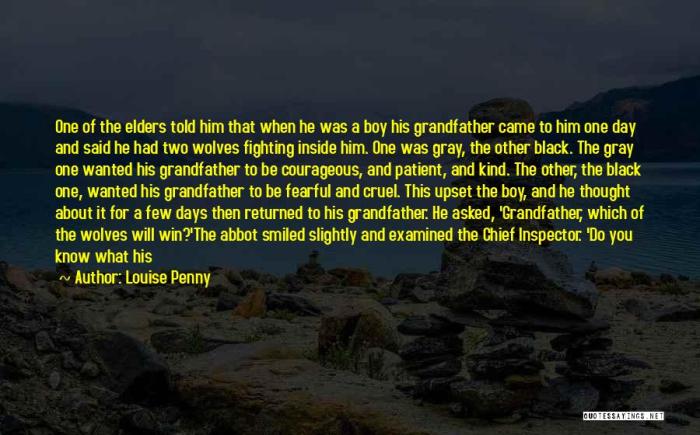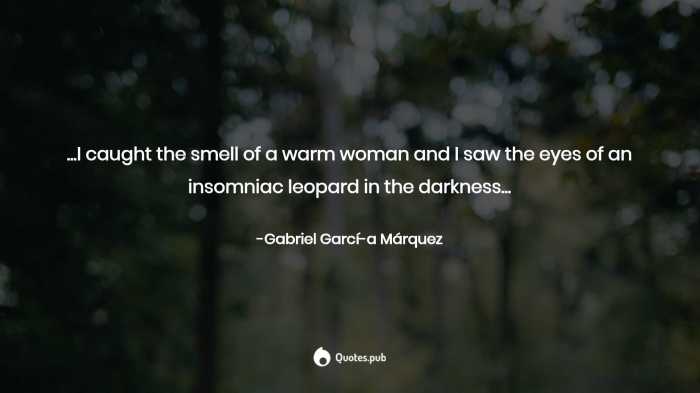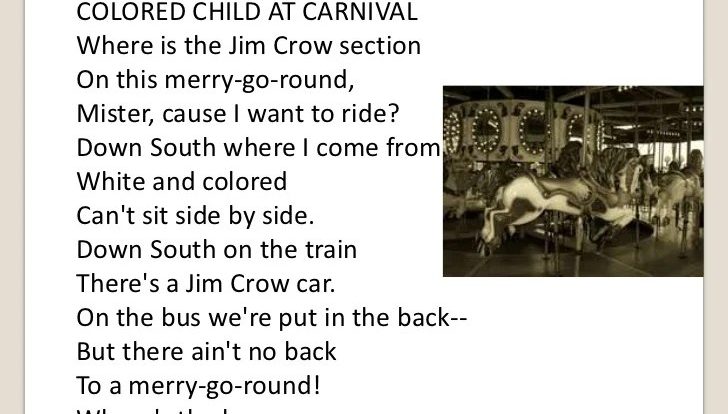Chronicle of a death foretold quotes – Delving into the depths of Gabriel García Márquez’s masterpiece, “Chronicle of a Death Foretold,” we embark on an exploration of its profound quotes, uncovering the intricate web of honor, revenge, and foreshadowing that permeates this timeless tale.
Through the voices of its unforgettable characters, the novel paints a vivid tapestry of human frailty and the inevitability of fate, leaving us with a haunting meditation on the consequences of our actions.
Character Analysis: Santiago Nasar

Santiago Nasar is the central character in Chronicle of a Death Foretold. He is a young man who is brutally murdered by the Vicario brothers in retaliation for the supposed deflowering of their sister, Angela. Santiago is a complex and enigmatic character, and his death is a tragedy that affects the entire community.
Santiago is a wealthy and well-respected member of the community. He is handsome, charming, and athletic. He is also known for his arrogance and his womanizing ways. Santiago’s relationships with others are often complex and difficult. He is close to his mother, Placida Linero, but he is often at odds with his father, Ibrahim Nasar.
Santiago also has a strained relationship with his fiancee, Flora Miguel. Despite his flaws, Santiago is a likeable and sympathetic character. He is a young man who is full of life and potential, and his death is a senseless waste of human life.
Symbolism Associated with Santiago
Santiago is associated with several symbols in the novel. These symbols help to develop his character and to foreshadow his death.
- The white horse:Santiago is often seen riding a white horse. The white horse is a symbol of purity and innocence. It also represents Santiago’s youth and vitality.
- The butterflies:Santiago is often surrounded by butterflies. The butterflies are a symbol of beauty and fragility. They also represent Santiago’s soul.
- The color yellow:Santiago is often wearing yellow clothing. The color yellow is a symbol of happiness and joy. It also represents Santiago’s optimism and hope for the future.
These symbols help to create a complex and nuanced portrait of Santiago. They also foreshadow his tragic death.
Santiago’s Actions and Choices, Chronicle of a death foretold quotes
Santiago’s actions and choices shape the events of the novel. His arrogance and his womanizing ways lead to his conflict with the Vicario brothers. His decision to go to the town square on the day of his murder is a fatal one.
Santiago’s actions and choices are not always wise, but they are always human. He is a young man who is trying to find his place in the world. He makes mistakes, but he also has the potential to be a great man.
His death is a tragedy, but it is also a reminder that we all have the potential to make mistakes and that we should always be careful about the choices we make.
Themes of Honor and Revenge

In Gabriel García Márquez’s “Chronicle of a Death Foretold,” the themes of honor and revenge play a central role in shaping the characters’ actions and the tragic events that unfold.
Honor, particularly male honor, is a highly valued concept in the conservative society depicted in the novel. It is closely tied to reputation, social status, and family lineage. Any perceived threat to one’s honor must be met with swift and decisive action, even if it results in violence.
Revenge as a Response to Honor
Revenge is often seen as the only way to restore honor after it has been damaged. In the novel, the Vicario brothers, Pedro and Pablo, feel obligated to avenge the loss of their sister Angela’s virginity to Santiago Nasar. They believe that killing Santiago will restore their family’s honor and reputation.
“They were going to kill him for honor,” the narrator says, “because they felt that their manhood had been mocked.”
The brothers’ pursuit of revenge is relentless and ultimately leads to Santiago’s death. Their actions are driven by a sense of duty and a desire to protect their family’s honor, even though it results in a senseless act of violence.
The Cycle of Violence
The themes of honor and revenge are closely intertwined and create a cycle of violence that perpetuates itself throughout the novel. The Vicario brothers’ revenge killing of Santiago Nasar only serves to further damage their family’s reputation and leads to more violence and bloodshed.
The novel’s tragic ending highlights the destructive consequences of a society that places such a high value on honor and revenge. It suggests that these themes can lead to a cycle of violence that is ultimately harmful to both individuals and the community as a whole.
Symbolism and Foreshadowing
Gabriel García Márquez’s Chronicle of a Death Foretoldis a masterclass in symbolism and foreshadowing, where every element contributes to the development of the plot and characterization. The novel’s intricate web of symbols and foreshadowing hints at the inevitable tragedy, building suspense and creating a sense of foreboding throughout the narrative.
Santiago Nasar’s Rooster
One of the most potent symbols in the novel is Santiago Nasar’s rooster. The rooster is a symbol of virility and masculinity, representing Santiago’s sexual prowess and the threat he poses to the honor of the Vicario brothers. Its crowing at the moment of Santiago’s death serves as a haunting reminder of the fatal consequences of his actions.
The Bishop’s Visit
The arrival of the bishop is another significant symbol in the novel. The bishop represents the Church’s authority and the moral order that the Vicario brothers seek to restore by killing Santiago. However, the bishop’s visit is met with indifference and skepticism, foreshadowing the community’s inability to prevent the tragedy.
The Butterfly
The butterfly that lands on Santiago’s hand just before his death is a symbol of the fragility of life and the inevitability of death. It also represents the fleeting nature of Santiago’s innocence and the transition from life to death.
Foreboding Dreams and Premonitions
Throughout the novel, characters experience foreboding dreams and premonitions that foreshadow Santiago’s death. For example, Santiago’s mother dreams of him being killed by birds, while the Vicario brothers have a vision of him covered in blood. These dreams and premonitions create a sense of inevitability and contribute to the growing tension and suspense.
Narrative Structure and Time
Chronicle of a Death Foretoldfeatures a unique narrative structure that plays a crucial role in shaping the reader’s understanding of events.
Nonlinear Timeline
The novel employs a nonlinear timeline, alternating between the present and past to recount the events leading up to Santiago Nasar’s murder. This structure allows the reader to piece together the story gradually, creating a sense of suspense and intrigue.
Multiple Perspectives
The story is narrated from multiple perspectives, including the unnamed narrator, Santiago Nasar’s family members, and the townspeople. This polyphonic narrative provides a comprehensive and nuanced view of events, allowing the reader to see the story from different angles.
Significance of the Ending
The novel’s ending is both abrupt and enigmatic. It reveals the identity of Santiago Nasar’s murderers but leaves many questions unanswered. This open-ended conclusion invites the reader to reflect on the events and their implications, highlighting the complex nature of honor, revenge, and justice.
Cultural and Historical Context

“Chronicle of a Death Foretold” is set in the fictional town of Sucre, Colombia, during the mid-20th century. The novel reflects the social and political realities of Colombia during this time period, which was characterized by:
Social Hierarchy and Violence
- Colombia was a deeply patriarchal society, with men holding most positions of power and authority.
- Violence was a common feature of Colombian life, both in the form of political violence and interpersonal violence.
- The novel explores the ways in which these social and political factors shape the lives of the characters and contribute to the tragedy that unfolds.
Political Climate
- Colombia was undergoing a period of political instability during the mid-20th century, with the country being torn between different political factions.
- The novel reflects the tensions and conflicts that existed within Colombian society at this time, and the ways in which these tensions contributed to the climate of violence.
- The novel also explores the role of the Catholic Church in Colombian society, and the ways in which the Church’s teachings and practices influenced the characters’ actions.
Economic Inequality
- Colombia was a country with a high level of economic inequality during the mid-20th century, with a small elite controlling most of the wealth and resources.
- The novel explores the ways in which economic inequality shaped the lives of the characters and contributed to the social and political tensions that existed within Colombian society.
- The novel also explores the role of the media in Colombian society, and the ways in which the media’s coverage of events can influence public opinion and shape the course of events.
FAQ Guide: Chronicle Of A Death Foretold Quotes
What is the significance of Santiago Nasar’s character in “Chronicle of a Death Foretold”?
Santiago Nasar represents the tragic hero, a flawed yet sympathetic figure whose fate is foreshadowed from the outset. His actions and choices, driven by honor and pride, ultimately lead to his untimely demise.
How does the novel explore the theme of honor and revenge?
“Chronicle of a Death Foretold” delves into the destructive consequences of blind adherence to honor and the cycle of violence it perpetuates. The characters’ actions are governed by a rigid code of honor, leading to tragic outcomes.
What is the role of symbolism and foreshadowing in the novel?
Symbolism and foreshadowing are integral to the novel’s structure and meaning. Objects, colors, and actions carry symbolic significance, hinting at future events and the characters’ destinies. Foreshadowing creates a sense of impending doom, as the reader becomes aware of the inevitable tragedy.
